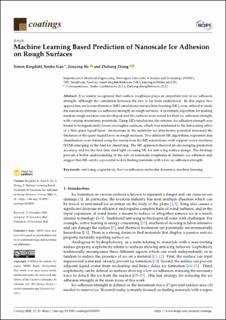| dc.contributor.author | Ringdahl, Simen | |
| dc.contributor.author | Xiao, Senbo | |
| dc.contributor.author | He, Jianying | |
| dc.contributor.author | Zhang, Zhiliang | |
| dc.date.accessioned | 2021-01-21T11:02:47Z | |
| dc.date.available | 2021-01-21T11:02:47Z | |
| dc.date.created | 2021-01-04T10:28:30Z | |
| dc.date.issued | 2021 | |
| dc.identifier.citation | Coatings. 2021, 11(1), . | en_US |
| dc.identifier.issn | 2079-6412 | |
| dc.identifier.uri | https://hdl.handle.net/11250/2724080 | |
| dc.description.abstract | It is widely recognized that surface roughness plays an important role in ice adhesion strength, although the correlation between the two is far from understood. In this paper, two approaches, molecular dynamics (MD) simulations and machine learning (ML), were utilized to study the nanoscale intrinsic ice adhesion strength on rough surfaces. A systematic algorithm for making random rough surfaces was developed and the surfaces were tested for their ice adhesion strength, with varying interatomic potentials. Using MD simulations, the intrinsic ice adhesion strength was found to be significantly lower on rougher surfaces, which was attributed to the lubricating effect of a thin quasi-liquid layer. An increase in the substrate–ice interatomic potential increased the thickness of the quasi-liquid layer on rough surfaces. Two different ML algorithms, regression and classification, were trained using the results from the MD simulations, with support vector machines (SVM) emerging as the best for classifying. The ML approach showed an encouraging prediction accuracy, and for the first time shed light on using ML for anti-icing surface design. The findings provide a better understanding of the role of nanoscale roughness in intrinsic ice adhesion and suggest that ML can be a powerful tool in finding materials with a low ice adhesion strength. | en_US |
| dc.language.iso | eng | en_US |
| dc.publisher | MDPI | en_US |
| dc.rights | Navngivelse 4.0 Internasjonal | * |
| dc.rights.uri | http://creativecommons.org/licenses/by/4.0/deed.no | * |
| dc.title | Machine Learning Based Prediction of Nanoscale Ice Adhesion on Rough Surfaces | en_US |
| dc.type | Peer reviewed | en_US |
| dc.type | Journal article | en_US |
| dc.description.version | publishedVersion | en_US |
| dc.source.volume | 11 | en_US |
| dc.source.journal | Coatings | en_US |
| dc.source.issue | 1 | en_US |
| dc.identifier.doi | 10.3390/coatings11010033 | |
| dc.identifier.cristin | 1864597 | |
| dc.relation.project | Notur/NorStore: NN9391K | en_US |
| dc.relation.project | Norges forskningsråd: 255507 | en_US |
| dc.relation.project | Notur/NorStore: NN9110 | en_US |
| dc.relation.project | Norges forskningsråd: 250990 | en_US |
| dc.description.localcode | This is an open access article distributed under the Creative Commons Attribution License which permits unrestricted use, distribution, and reproduction in any medium, provided the original work is properly cited | en_US |
| cristin.ispublished | true | |
| cristin.fulltext | original | |
| cristin.qualitycode | 1 | |

